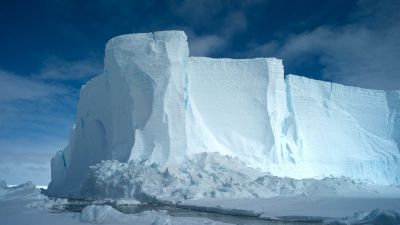
BENEMELT: Melting ice shelves in East Antarctica
The BENEMELT project aims to investigate how much snow melts on the ice shelves in East Antarctica, by how much that melt will increase in the future, and how that will impact ice shelf stability and a resulting rise in global sea levels.
Ice Shelves Stability and Sea-Level Rise
Ice shelves are floating extensions of the ice sheet, and help to keep the upstream ice in place. As the climate becomes warmer, increasing surface melt on these shelves may destabilize them, which could result in a greater probability of increasing ice loss from Antarctica and subsequent sea level rise.
The BENEMELT project will bring together researchers from Belgium (KU Leuven and Université Libre de Bruxelles) and the Netherlands (Utrecht University). The researchers aim to improve understanding of snow melt on ice shelves and how melt will impact on ice shelf stability and sea level.
To that end, they will observe the weather on these ice shelves, measure the amount of surface melt from the ground and from satellites, and analyse how snow characteristics change in response to melt. All these observations will be combined to improve climate models, which will provide an estimate of present-day and future surface melt on the East Antarctic ice shelves.
Dr. Jan Lenaerts, a young researcher based at the Institute for Marine and Atmospheric Research at the University of Utrecht (The Netherlands) was awarded the 2014 InBev-Baillet Latour Antarctica Fellowship for the BENEMELT project. When asked about the objectives of the project, he answers:
"East Antarctica is the earth’s largest ice body. If the planet warms, the ice shelves holding all this ice in place could break off, leading to massive discharge of ice in the ocean and potential sea level rise of tens of meters. My fieldwork with the support of the InBev-Baillet Latour Fellowship will shed light on which processes are responsible for this ice shelf breakup, thereby improving the estimates how, when and where East Antarctica is most vulnerable to global warming".
Work during the BELARE expeditions
The project consists of two field campaigns on the Roi Baudouin ice shelf during the 2014/2015 and 2015/2016 Antarctic summer seasons:
- During the first season, Jan Lenaerts will spend three weeks working on the Roi Baudouin ice shelf. A weather station will be installed on the ice shelf, which will provide high-quality meteorological data. The team will also install temperature sensors inside the snowpack to study the impact of melt on snow temperature, deploy ground-penetrating radar and drill several firn cores to detect melt layers and determine snow density along a transect.
- During the second season (2015/2016), the team will camp on the ice shelf for several weeks to measure snow albedo, snow grain size, snow density, and melt layers.
Picture: Ice Shelf near Crown Bay, East Antarctica - © International Polar Foundation / René Robert
